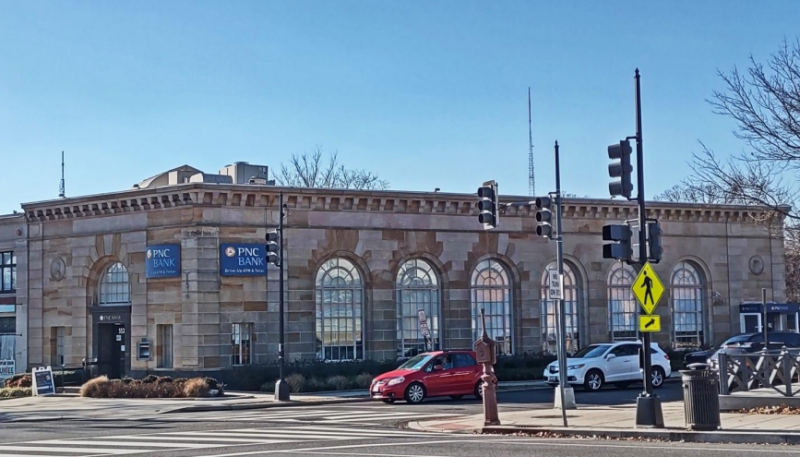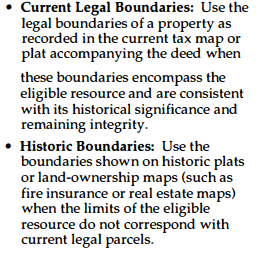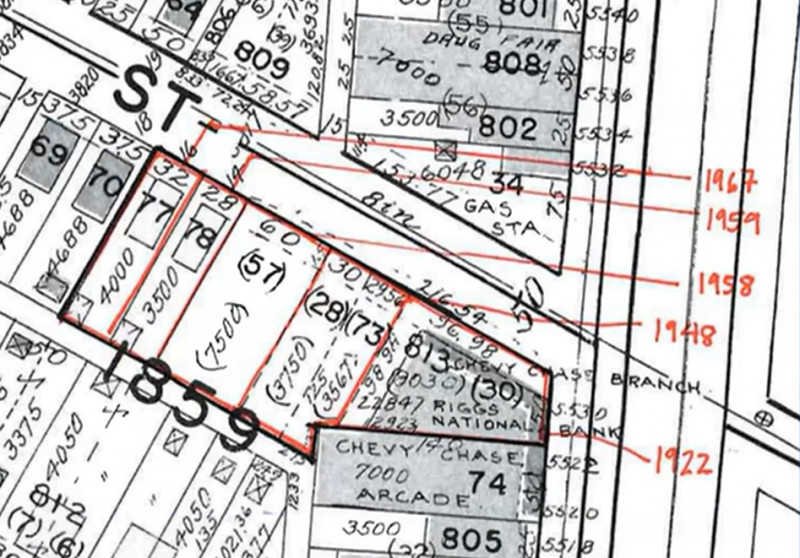DC’s historic board voted to protect a non-historic parking lot. Why?

Chevy Chase Savings Bank. Image via a DC Historic Preservation Office Staff report.
At its Jan. 23, 2023 meeting, the District of Columbia’s Historic Preservation Review Board (HPRB) voted unanimously to designate the Chevy Chase Savings Bank at 5530 Connecticut Avenue NW (currently owned by PNC), as a historic landmark. The landmarking of the building follows HPRB’s established norms, but the inclusion of a parking lot adjacent to the site seems to violate the board’s own precedent and national historic guidance.
HPRB found that the lot does not merit historic preservation, but chose to subject it to historic review regardless. Nothing in the official case record presents a justification for this, but public comments prior to the hearing indicate the applicants’ intention was to deliberately expand the nomination boundaries to prevent too tall a building from being built on the lot in the future.
In statements to ANC 3/4G, an officer from Historic Chevy Chase, which, alongside the DC Preservation League (DCPL), filed the nomination, said his organization was worried that a new building might “dwarf” and “overshadow” its surroundings and ruin the street’s “ambiance.” Using the historic nomination process like this to control future land use is supposed to be impermissible; the law is supposed to exclusively evaluate the historic merits of any potential landmark.
But while HPRB had the ability to arrest this maneuver, it instead chose to indulge it. Now approved, future development on the parking lot is subject to HPRB’s design review process and will be evaluated for compatibility with the adjacent landmark. That process functionally overrides zoning by subjecting “height and mass” to historic review, and thus dampens the potential for more housing, and more affordable housing, in one of the District’s most affluent areas.
Precedent-less preserved parking
As Historic Chevy Chase and DCPL argue in their application for landmark status for it, the bank is historically significant for both its architecture and its social history. Constructed in 1926 and expanded in 1958, the Italian Renaissance Revival building served the financial needs of residents of Chevy Chase, then a developing neighborhood, and is a visual example of the kind of banks constructed during that period.
But while Historic Chevy Chase and DCPL’s application makes the case for the bank’s historic value, it presents no evidence for the adjoining parking lot, nor is any justification included in the accompanying Historic Preservation Office (HPO) staff report. Despite that, the application proposed (and the staff report supported) the boundaries of the landmark to include the bank building and the parking lot.
This map, from Historic Chevy Chase and DCPL’s application for landmark status for the Chevy Chase Bank Building, shows the proposed boundaries in yellow covering the bank building on the corner and the rear parking lot. Source: Nomination 
When reached in March, DCPL Executive Director Rebecca Miller said the bank and the parking lot share a single tax lot, and that DCPL uses tax-lot boundaries when drafting nominations. This, she said, is consistent with guidance from the National Register of Historic Places which instructs applicants to use the “current legal boundaries” of the desired landmark as a guide. Further, Miller said, the relevant section of the DC Code contains “no discussion…about splitting lot lines.”
To read these references as not just allowing but requiring the use of legal boundaries is a reach. The National Register’s guidance on “current legal boundaries” is only one element applicants are instructed to take into account. The Register’s bulletin on the matter contains equivalent guidance to consider historic boundaries, specifically in cases “when the limits of the eligible resource do not correspond with current legal parcels.”
That describes the Chevy Chase bank property well: The footprint of the bank—the contributing resource—matches the historic lot it sat on prior to the construction of the parking lot, not the modern one including the parking.
Source: Defining Boundaries for National Register Properties 
HPO and HPRB have repeatedly confirmed the use of historic boundaries over modern ones, including in response to a DCPL application in the 2018 case of the Washington Animal Rescue League Shelter. Other cases that use historic boundaries over modern ones include:
- 2010 - John J. Earley Office and Studio
- 2014 - Park View Christian Church
- 2014 - Hebrew Home for the Aged & Jewish Social Service Agency
- 2015 - Lunch Room and Oyster Shucking Shed
- 2020 - Washington Yacht Club
- 2022 - Seafarers Yacht Club
The most prominent example is one that has recently been taken to court over this exact issue. Neighbors of the Scottish Rite Masonic Temple, on 16th Street NW, sued HPRB for using the temple’s historic boundary lines. (The backstory involves a sloppy, transparently bad-faith attempt to stop development on a parking lot.) In response, not only did HPO reassert this decision, the Office of Attorney General (OAG) weighed in as well. In its brief for the appeal, OAG cites the National Register’s Defining Boundaries, discussed above, to anchor its opinion:
“Current legal boundaries are just one possible tool for defining a landmark site…The deeper principle is that landmark boundaries should ‘encompass but not exceed the extent of the significant resources and land areas comprising the property.”
The quiet part out loud
Additionally, Miller’s explanation doesn’t align with that of Jordan Benderly, Historic Chevy Chase’s community liaison officer.
At a January 2023 ANC 3/4G meeting discussing the application, several commissioners were confused about the boundaries shown in the application; a majority were interested in supporting a designation of the building but wanted to ensure that doing so would not preclude development on the parking lot.
Benderly confirmed that Historic Chevy Chase and DCPL were not trying to prevent all development on the parking lot by landmarking it as a historic resource. However, he was clear that the potential size of that future development was a major concern—hence the assertion that “too large a building” might “dwarf” and “overshadow” its surroundings and ruin the street’s “ambiance.” Including the parking lot in the landmark’s boundaries protects against that outcome, he said, by ensuring that any future building on the lot will still go through historic design review, no doubt minimizing its resulting size.
A battle in the larger war
This is particularly disappointing because Chevy Chase is the poster child for DC’s wealthy, white neighborhoods that have historically used exclusionary zoning to keep out new housing, both market-rate and income-restricted, subsidized (“affordable”) housing. The neighborhood’s zoning, which is primarily R1-B and R-2 explicitly identify that exclusion in their stated purposes to “stabilize the residential areas and promote a suitable environment for family life,” and “protect these areas from invasion by denser types of residential development,” respectively. Chevy Chase’s zoning lets its residents avoid dealing with pains of growth, real or perceived, and “protects” them from accommodating a fair share of new housing.
Lately, the District has tiptoed towards shifting that status quo. Updates to the 2006 Comprehensive Plan, passed by the DC Council in 2021, and the Chevy Chase Small Area Plan (SAP), produced by the Office of Planning last year, have suggested a pathway that might allow new housing in the neighborhood. The SAP identifies the bank’s site as one of the few in Chevy Chase that can accommodate infill housing.
PNC bank site is identified in the Chevy Chase Small Area Plan as one of nine sites where infill development might be possible within the area, subject to a future zoning map amendment. Source: Chevy Chase Small Area Plan 
But those efforts—which are hardly radical—have provoked a backlash among those to whom more housing, and more affordable housing, is a threat. That reaction has manifested as strident opposition to the small area plan and in renewed conversations about applying for a neighborhood historic district that is explicitly framed as a countermeasure to the Comprehensive Plan changes. (This is an increasingly common tactic around the city.)
Preemptively limiting the scale of infill development on a parking lot by surreptitiously sliding it into a landmark application for a specific building is of the same ilk
A conspicuous restraint
Using historic designation to control future land use like this is supposed to be legally out of bounds. As HPRB is eager to make very clear when it ignores concerns about the deleterious effects of historic designation, its purview is exclusively to evaluate the merits of an individual application against the historic criteria. The applicants, wisely, then, didn’t use the talking points Benderly gave to ANC 3/4G in their official nomination document, or at the hearing. Absent any legal justification for more expansive boundaries though, HPO and HPRB should have easily followed their own precedent and right-sized them to the historic ones.
Confusingly, they got halfway there. In HPO’s presentation at the HPRB hearing, staffer Kim Williams made a clear case against the designation of the parking lot, as it was not present when the bank was originally constructed. As she documented, the bank acquired the five lots that now constitute the parking lot over the course of twenty years, consolidating them all, plus the bank lot, into a single property lot in 1968.
Map showing the dates each lot constituting the property was acquired. Image from HPO staff presentation at January 26th, 2023 hearing. 
But instead of advising HPRB to exclude the parking lot—in line with HPRB’s many previous decisions to use historic, not current tax-lot, boundaries in cases like this—Williams offered Benderly’s solution: Leave the parking lot within the landmark boundaries, as applied for by DCPL and Historic Chevy Chase, but declare it a “non-contributing resource.”
When PNC’s director of operations, Patrick Finegan, asked whether it would be better to subdivide the lots first in order to allow a designation of just the bank “and not impact the parking lot” (51:18), Williams doubled down. She said HPRB did have the option to reduce the boundaries, but said this “doesn’t change much” because subdivision would be required either way.
This answer is incomplete at best. It’s true that the subdivision process will be largely the same in all scenarios, but subdivision won’t be the most significant regulatory hurdle to developing the lot. Williams’s answer excluded any discussion of the design review process, which, as mentioned before, has the power to completely supersede a site’s zoning and radically change the scale of a future building. That difference is enormously significant—both in terms of the financial value to PNC and for what kind of housing and amenities might come to the community.
The parking lot in question. Source: Nomination .png)
For those who want to exercise as much power as they can over new development on PNC’s parking lot, that’s exactly the point. But those people aren’t everyone, and don’t reasonably constitute the “community,” or the “public”; yielding to their interests hurts the overall health of the District, which is depending on adding more housing.
Historic preservation advocates and officials generally resent any implication that their work sometimes stands as an obstacle to this goal. But if they want to be taken seriously, they need to actively work to root out bad-faith abuse of the preservation process, not facilitate it.
This article has been updated to reflect the correct order of the third and fourth images, along with adding an image of the parking lot.
